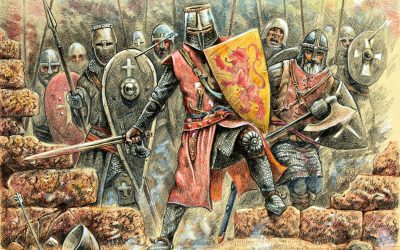Richard the Lionheart, also known as Richard I of England, was a central figure of the Third Crusade and one of the most famous warriors of his time. Born on 8 September 1157, Richard was the third of five sons of King Henry II of England and Eleanor of Aquitaine. His reign as King of England lasted from 1189 until his death in 1199, but he spent very little time in England itself, focusing instead on his lands in France and his Crusade in the Holy Land.
Early life and ascension to the throne
Richard grew up with considerable military training and experience, showing a keen interest in the art of war from an early age. Before becoming king, he already held the title of Duke of Aquitaine, a position he inherited from his mother, which gave him substantial lands and influence in France.
Upon his father’s death in 1189, Richard ascended to the throne of England. However, his ambition and interests lay far beyond the English Channel. Shortly after his coronation, he took the cross, pledging to lead a Crusade to the Holy Land to recapture Jerusalem from Muslim control.
Role in the Third Crusade
The Third Crusade (1189–1192) was launched in response to the capture of Jerusalem in 1187 by Saladin, the Sultan of Egypt and Syria. Richard led the Christian effort alongside Philip II of France and Frederick I Barbarossa of the Holy Roman Empire. Richard’s reputation as a military leader was solidified during this campaign, where his bravery, tactical skills, and persistence in the face of adversity earned him the epithet “Lionheart.”
Despite achieving several military victories, including the capture of the important city of Acre and notable successes in battles such as Arsuf, Richard and his allies were unable to recapture Jerusalem. However, he succeeded in securing safe passage for Christian pilgrims to the Holy Land through a truce with Saladin.
Later Years and Death
Richard’s return from the Crusade was marked by difficulties. He was captured near Vienna by Duke Leopold V of Austria, whom he had insulted during the Crusade. He was subsequently handed over to the Holy Roman Emperor Henry VI, who held him for ransom. His captivity lasted from December 1192 until February 1194, when the ransom was finally paid.
After his release, Richard focused on securing his territories in France against Philip II. He spent the remainder of his reign engaged in military campaigns in France, seeking to defend and expand his holdings. Richard died on 6 April 1199 from an infection caused by an arrow wound received during the siege of the castle of Châlus-Chabrol in Limousin.
Legacy

Richard the Lionheart’s legacy is complex. In England, he is remembered as a hero of the Crusades and a quintessential warrior king. However, his frequent absences from the country and the heavy taxation imposed to fund his campaigns strained his relationship with his English subjects and left the royal treasury nearly empty. Despite this, his prowess in battle and his role in the Crusades have cemented his place as one of the most iconic figures of medieval Europe.






Leave a Reply